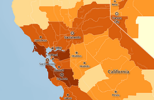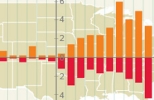-
Topics
Population, Economy -
Geography
Maps, Geographic Data -
Library
Infographics, Publications -
Data
Tools, Developers -
About the Bureau
Research, Surveys -
Newsroom
News, Events, Blogs
- Topics
-
Introducing a new way to navigate by topics. Access the latest news, data, publications and more around topics of interest.
- Population
-
Our population statistics cover age, sex, race, Hispanic origin, migration, ancestry, language use, veterans, as well as population estimates and projections.
Age and Sex- Ancestry
- Children
- Foreign Born
- Hispanic Origin
- International
- Language Use
- Migration/Geographic Mobility
- Population Estimates
- Population Projections
- Race
- Veterans
- Economy
-
The U.S. Census Bureau is the official source of statistical data tracking the national economy.
Classification Codes (i.e., NAICS)- Economic Census
- Economic Indicators
- Economic Studies
- Industry Statistics Portal
- Other Economic Programs
- Business
-
Business is a large part of America's diverse economy. This section provides key information about businesses in your community.
Get Help with Your Form- Business Characteristics
- Classification Codes (i.e., NAICS)
- Construction
- Manufacturing
- Mining
- Retail Trade
- Services
- Wholesale Trade
- Education
-
This section provides information on a range of educational topics, from educational attainment and school enrollment to school districts, costs and financing.
Educational Attainment- Educational Services
- Public School System Finances
- School Districts
- School Enrollment
- Teaching about Statistics
- Employment
-
We measure the state of the nation's workforce, including employment and unemployment levels, weeks and hours worked, occupations, and commuting.
Commuting (Journey to Work)- County Business Patterns
- Disability Employment Tabulation
- Employers: Public Sector
- Equal Employment Opportunity Tabulation
- Industry and Class of Worker
- Labor Force Statistics
- Local Employment Dynamics (LED)
- Occupation
- Public Sector Employment and Payroll
- Survey of Business Owners
- Work from Home
- Families & Living Arrangements
-
Our statistics highlight trends in household and family composition, describe characteristics of the residents of housing units, and show how they are related.
Child Care- Children
- Families and Households
- Fertility
- Grandparents and Grandchildren
- Marriage and Divorce
- Same-sex Couples
- Health
-
Health statistics on insurance coverage, disability, fertility and other health issues are increasingly important in measuring the nation’s overall well-being.
Disability- Expenses and Investments
- Fertility
- Health Care Industries
- Health Insurance
- HIV/AIDS
- Small Area Health Insurance Estimates
- Social Assistance Industries
- Housing
-
We measure the housing and construction industry, track homeownership rates, and produce statistics on the physical and financial characteristics of our homes.
Financial Characteristics- Homeownership
- Housing Vacancies
- Multifamily Housing
- New Housing (Construction)
- Physical Characteristics
- Rental Housing
- Residential Financing
- Income & Poverty
-
Income is the gauge many use to determine the well-being of the U.S. population. Survey and census questions cover poverty, income, and wealth.
Income- Income Inequality
- Poverty
- Public Assistance
- Small Area Income and Poverty
- Supplemental Poverty Measure
- Wealth
- International Trade
-
The U.S. Census Bureau is the official source for U.S. export and import statistics and regulations governing the reporting of exports from the U.S.
Automated Export System (AES/AES Direct)- Commodity Classification (Schedule B)
- Foreign Trade Regulations (FTR)
- Import and Export Data
- Reference
- Public Sector
-
The U.S. Census Bureau provides data for the Federal, state and local governments as well as voting, redistricting, apportionment and congressional affairs.
Building Permits- Census of Governments
- Congressional and Intergovernmental
- Congressional Apportionment
- Criminal Justice
- Emergency Preparedness
- Government Employment & Payroll
- Government Finances
- Government Organization
- Government Taxes
- Redistricting Data
- Voting and Registration
- Index A-Z
-
Search an alphabetical index of keywords and phrases to access Census Bureau statistics, publications, products, services, data, and data tools.
- Geography
-
Geography provides the framework for Census Bureau survey design, sample selection, data collection, tabulation, and dissemination.
- About
-
Geography is central to the work of the Bureau, providing the framework for survey design, sample selection, data collection, tabulation, and dissemination.
- Education
-
Find resources on how to use geographic data and products with statistical data, educational blog postings, and presentations.
- GSS Initiative
-
The Geographic Support System Initiative will integrate improved address coverage, spatial feature updates, and enhanced quality assessment and measurement.
- Interactive Maps
-
Work with interactive mapping tools from across the Census Bureau.
- Maps & Data
-
Find geographic data and products such as Shapefiles, KMLs, TIGERweb, boundary files, geographic relationship files, and reference and thematic maps.
- Metropolitan & Micropolitan
-
Metropolitan and micropolitan areas are geographic entities used by Federal statistical agencies in collecting, tabulating, and publishing Federal statistics.
- Partnerships
-
Find information about specific partnership programs and learn more about our partnerships with other organizations.
- Reference
-
Definitions of geographic terms, why geographic areas are defined, and how the Census Bureau defines geographic areas.
- Research
-
We conduct research on geographic topics such as how to define geographic areas and how geography changes over time.
- Library
-
Visit our library of Census Bureau multimedia files. Collection formats include audio, video, mobile apps, images, and publications.
- Audio
-
Collection of audio features and sound bites.
- Infographics
-
infographics include information on the Census Bureau's history of data collection, our nation's veterans and the American Community Survey.
- Photos
-
Browse Census Bureau images.
- Publications
-
Read briefs and reports from Census Bureau experts.
- Video
-
Watch Census Bureau vignettes, testimonials, and video files.
- Working Papers
-
Read research analyses from Census Bureau experts.
- Data
-
Access data through products and tools including data visualizations, mobile apps, interactive web apps and other software.
- Data Tools and Apps
-
Find information using interactive applications to get statistics from multiple surveys.
American FactFinder- Census Explorer
- Easy Stats
- Interactive Population Map
- My Congressional District
- Population Clock
- Quick Facts
- Developers
-
Developer portal to access services and documentation for the Census Bureau's APIs.
- Mobile Apps
-
Explore Census Bureau data on your mobile device with interactive tools.
- Product Catalog
-
Find a multitude of DVDs, CDs and publications in print by topic.
- Related Sites
-
These external sites provide more data.
- Software
-
Download extraction tools to help you get the in-depth data you need.
- Training & Workshops
-
Learn more about our data from this collection of e-tutorials, presentations, webinars and other training materials. Sign up for training sessions.
- Visualizations
-
Explore Census data with interactive visualizations covering a broad range of topics.
- About the Bureau
-
How we provide the best mix of timeliness, relevancy, quality, and cost for the data we collect.
- Who We Are
-
Information about the U.S. Census Bureau.
- What We Do
-
Information about what we do at the U.S. Census Bureau.
- Our Research
-
Our researchers explore innovative ways to conduct surveys, increase respondent participation, reduce costs, and improve accuracy.
- Our Surveys and Programs
-
Our surveys provide periodic and comprehensive statistics about the nation, critical for government programs, policies, and decisionmaking.
Are You in a Survey?- 2020 Census
- 2015 Census Tests
- 2010 Census
- American Community Survey (ACS)
- American Housing Survey (AHS)
- Economic Census
- Special Census Program
- Survey of Income and Program Participation
- Business Opportunities
-
Learn about other opportunities to collaborate with us.
- History
-
Explore the rich historical background of an organization with roots almost as old as the nation.
- Census Careers
-
Explore prospective positions available at the U.S. Census Bureau.
- Field Jobs by State
-
Information about the current field vacancies available at the U.S. Census Bureau Regional Offices.
- Newsroom
-
The latest press releases and statements from the U.S. Census Bureau. Also, find upcoming events, and useful information for journalists and media.
- Director's Blog
-
The Census Bureau's Director writes on how we measure America's people, places and economy.
- Facts for Features
-
Find interesting and quirky statistics regarding national celebrations and major events.
- Profile America
-
Listen to audio files on fun facts, historical figures, and celebrations of the month.
- News Releases
-
Find media toolkits, advisories, and all the latest Census news.
- Tip Sheets
-
See what's coming up in releases and reports.
A new edition of the interactive mapping tool, Census Explorer, illustrates characteristics of young adults (age 18-34) across the decades using data from the 1980, 1990 and 2000 Censuses and the 2009-2013 American Community Survey.
A new edition of the interactive mapping tool, Census Explorer, illustrates characteristics of young adults (age 18-34) across the decades using data from the 1980, 1990 and 2000 Censuses and the 2009-2013 American Community Survey.
Latest News






























